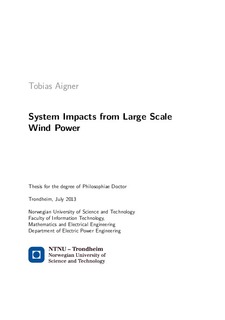| dc.contributor.author | Aigner, Tobias | nb_NO |
| dc.date.accessioned | 2014-12-19T13:53:52Z | |
| dc.date.available | 2014-12-19T13:53:52Z | |
| dc.date.created | 2013-07-24 | nb_NO |
| dc.date.issued | 2013 | nb_NO |
| dc.identifier | 638548 | nb_NO |
| dc.identifier.isbn | 978-82-471-4508-1 [printed ver.] | nb_NO |
| dc.identifier.isbn | 978-82-471-4510-4 [electronic ver.] | nb_NO |
| dc.identifier.uri | http://hdl.handle.net/11250/257447 | |
| dc.description.abstract | The objective of the European Union to increase the share of renewable energy sources and Wind Power Production in particular, will be a severe challenge for the power system. Unscheduled production changes and remaining forecast deviations will require more control actions and a tighter interconnection between areas. To benefit from distributed generation and geographical smoothing, grid reinforcements and the commissioning of new cross-border interconnections will be necessary. Furthermore, a regulatory framework to exchange energy across country borders has to be established. This thesis studies the impacts of Wind Power Production on the European power system and proposes measures for its efficient and secure integration. These measures include a cost-optimal grid expansion in the European transmission system and the integration of intra-day and regulating power markets in Northern Europe and the Nordic area.
The thesis is divided into two parts. Part I includes a detailed description of the developed and the applied models. The research includes the development of a detailed model simulating onshore and offshore wind power production on a European level. The production time series data is used as an input to a mathematical model simulating an integrated Northern European intra-day and regulating power market, developed in the course of the thesis. Furthermore, a joint model was established simulating a cost-optimal grid expansion under the the influence of large scale wind power and its effects on a common European day-ahead market.
Part II includes a set of analyses carried out on the aforementioned models. The investigated cases analyse the influence of wind power production on the power system and the power markets, including scenarios for the years 2010, 2020 and 2030. For these scenarios the wind power production is simulated, analysing wind power production variability and the affects on net-load variations in the European system. Cost-optimal grid expansion scenarios for inter-area and cross-border connections are evaluated. Their affect on day-ahead market prices,price volatility and the inter-area load flow is investigated. Taking into account changes in the production portfolio and including the variability of wind power production, the possibility of an integrated regulating power market in Northern Europe is analysed for the years 2010 and 2020. Finally, the possibility of an integrated intra-day market is investigated. It is shown that the integration of national intra-day and regulating power markets can significantly reduce system imbalances and hence costs in the respective market areas. | nb_NO |
| dc.language | eng | nb_NO |
| dc.publisher | Norges teknisk-naturvitenskapelige universitet, Fakultet for informasjonsteknologi, matematikk og elektroteknikk, Institutt for elkraftteknikk | nb_NO |
| dc.relation.ispartofseries | Doktoravhandlinger ved NTNU, 1503-8181; 2013:198 | nb_NO |
| dc.title | System Impacts from Large Scale Wind Power | nb_NO |
| dc.type | Doctoral thesis | nb_NO |
| dc.contributor.department | Norges teknisk-naturvitenskapelige universitet, Fakultet for informasjonsteknologi, matematikk og elektroteknikk, Institutt for elkraftteknikk | nb_NO |
| dc.description.degree | PhD i elkraftteknikk | nb_NO |
| dc.description.degree | PhD in Electric Power Engineering | en_GB |
